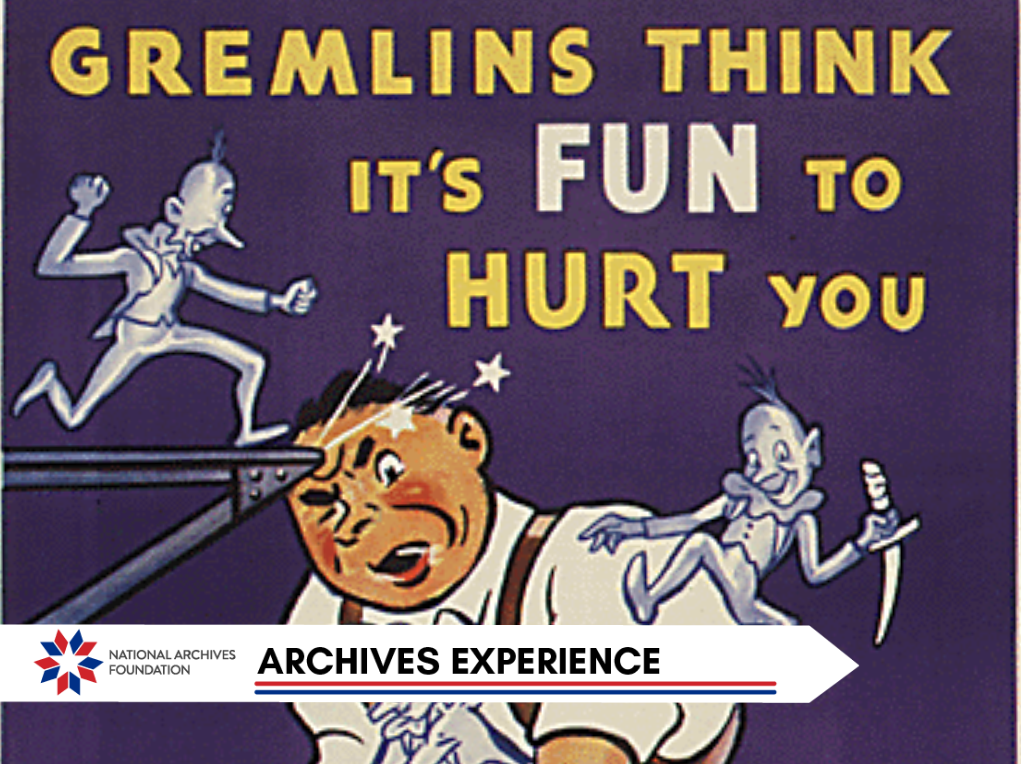Are gremlins back?

Have you noticed any glitches in your computer? Are your clocks losing time? Does your smartphone seem less smart? We know why: gremlins. Today’s newsletter sheds light on a report that documents the resurgence of gremlins in the United States. These not-so-mythical creatures are making their presence known here at the Foundation. Are you experiencing gremlin activity too? Read on for the full report…
Curious Timing on Newly Discovered Gremlins Report
Executive Summary: In recent months, a notable resurgence has been reported in incidents involving the appearance and activities of gremlins in various sectors impacting the daily life of Americans. This report analyzes the phenomenon, assesses its implications, and recommends appropriate measures for containment and management.

Gremlins are floor greasers! Watch your step! Back up our battleskies!
National Archives Identifier: 535378
Background: Gremlins as destructive little creatures originated in British fairy tales. It is believed that the word “gremlin” comes from the Old English word “gremian,” which means “to vex.” Dating back to World War II aviation folklore, the legendary creatures are known for their propensity to cause mischief and mechanical failure. They were brought to the general public’s attention through the publication of Roald Dahl’s 1943 book The Gremlins, which was commissioned by Walt Disney for a film that was never realized. Reports say gremlins sabotaged the film studio’s equipment and destroyed all documentary evidence. Some say that Dahl himself inadvertently brought gremlins to Los Angeles in his suitcase when he came to visit Disney. From there, the gremlins proliferated throughout American air bases. By 1984, gremlins had taken over the film production company Warner Bros. Pictures and demanded to have a film made about them. The studio had no choice but to make the blockbuster Gremlins and its sequels Gremlins 2: The New Batch and Gremlins 3: Dawn of Desmond.

Gremlins love to pitch things at your eyes. Wear safety goggles. Back up our battleskies!
National Archives Identifier: 535379

Gremlins will push you ’round! Look where you’re going! Back up our battleskies!
National Archives Identifier: 535380

Gremlins think it’s fun to hurt you. Use care always. Back up our battleskies!
National Archives Identifier: 535381
Incident Analysis: Numerous recent accounts describe inexplicable malfunctions in electronic devices, including computers and smartphones. In recent weeks, malfunctioning computers have confounded archivists, historians, researchers, and the Foundation employee writing this report. Unplugging and plugging devices back in had no discernible effect.
Implications: Gremlin activity may confuse the public because they receive educational and entertaining historic newsletters on reliable websites devoted to showcasing the National Archives.
Recommendations
Public Awareness Campaigns: Educating the public about gremlin mythology and the potential risks associated with their re-emergence is essential.
Research and Development: Investment in collaborations between government institutions, academic researchers, and technology companies can facilitate the development of ethical nonlethal gremlin entrapment, rehabilitation, training, and education.
Conclusion: The reappearance of gremlins in daily life represents a complex and multifaceted challenge. Proactive safety efforts will ensure future generations can continue to enjoy their annual April Fool’s Day.
If you are experiencing gremlin activity, please contact the Foundation’s gremlin incident center by completing this form so we can share your report on social media. We hope you enjoyed reading our April Fool’s Day banter. Gremlins aside, history can be fun to share.
If you like what we do at the Foundation, you can make a gift to help us continue to inspire a deeper appreciation of our country’s heritage through the collected evidence of its history.





